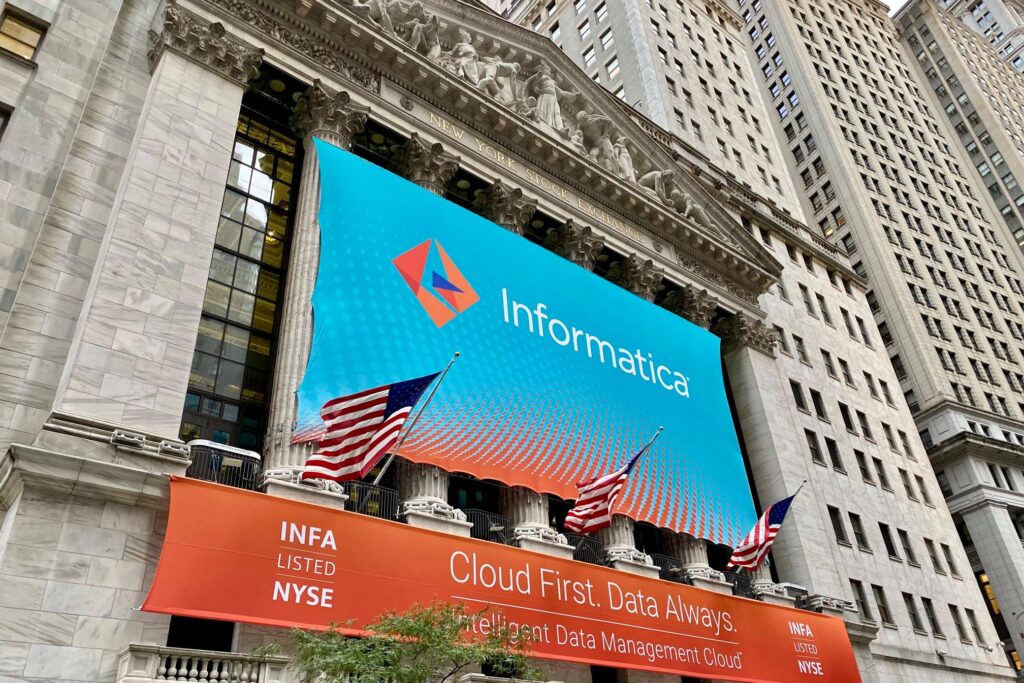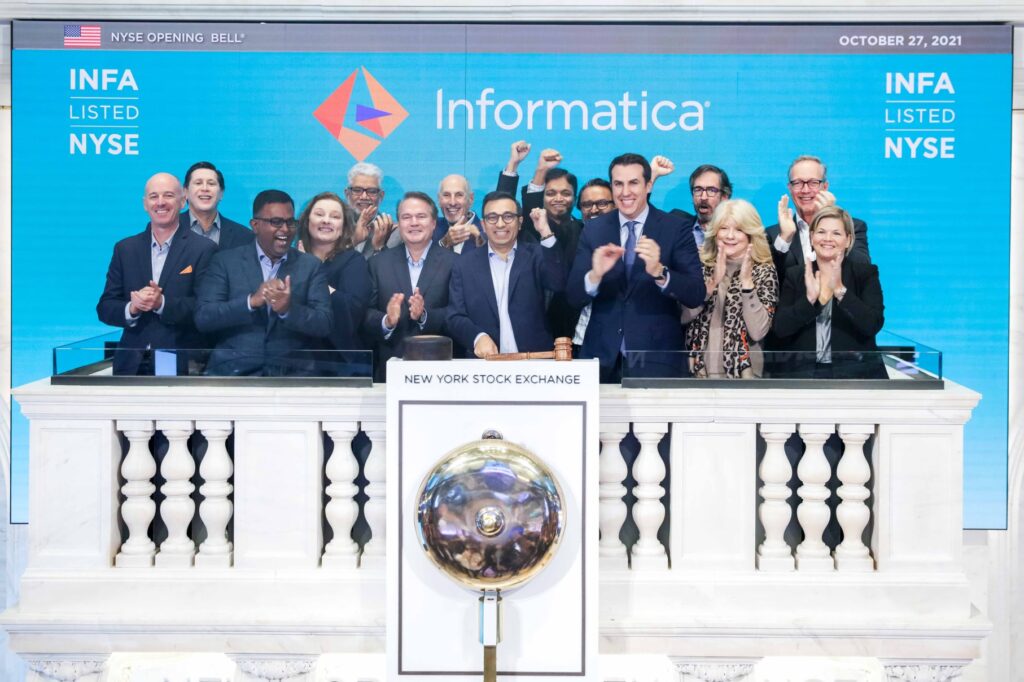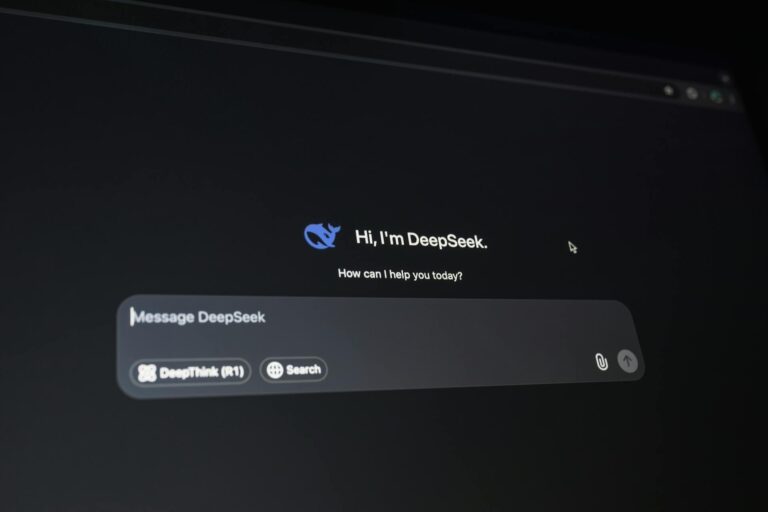
After more than six years of operating as a private business, software company Informatica returned to the public arena at the end of October when it listed on the New York Stock Exchange, raising around $840 million in its first day of trading.
When Informatica went private in 2015, its annual recurring revenue was around $600 million, out of which about $90 million was subscription revenue. That has since doubled to $1.2 billion with about $700 million in subscriptions and cloud is the biggest driver of this growth, tracking the overall industry trend towards cloud migration.

Informatica says that the company of today is night and day to the one that went private six years ago, having pivoted from a single product company to one that has multiple offerings in various markets, underpinned by its Intelligent Data Management Cloud, which is running more than 22 trillion cloud transactions a month for its clients.
Its CEO Amit Walia recently described Informatica as being the “Switzerland of data” due to its ability to connect “anything to anything”. It has used its time in the private space to complete this business transformation, spending somewhere in the region of $1 billion on research and development, building out its new products and cloud-native platform and integrating AI and ML into its offering.
With that metamorphosis complete, the company’s leaders felt a public listing represented the best path forward.
It’s super exciting for us at Informatica to see ourselves listed on the New York Stock Exchange
“It’s super exciting for us at Informatica to see ourselves listed on the New York Stock Exchange.” says Greg Hanson, VP EMEA at Informatica, speaking to Digital Bulletin. “We’ve really been on a journey over the past six years to establish ourselves as an organisation that is able to enable any kind of company with any flavour of cloud infrastructure to accelerate and optimise its digital transformation initiative.”
Central to achieving that goal is the Intelligent Data Management Cloud, designed to help businesses innovate with their data on any platform, any cloud, multi-cloud and multi-hybrid and for all users across the enterprise. Launched in April 2021, the platform has been built to enable data integration, app integration, API and data management at scale, allowing customers to connect, access, consume and govern their data wherever it flows.
“Informatica was established 26 years ago to pull data together. But the size and complexity that we see today is unlike anything we have ever seen before with data spread across a hybrid landscape of multiple clouds, while many larger organisations also have heritage silos on-prem. Those data volumes are doubling on an annual basis, while more complexity and governance is also being added,” says Hanson.
Data Hungry
“Informatica was established 26 years ago to pull data together. But the size and complexity that we see today is unlike anything we have ever seen before with data spread across a hybrid landscape of multiple clouds, while many larger organisations also have heritage silos on-prem. Those data volumes are doubling on an annual basis, while more complexity and governance is also being added,” says Hanson.
“Organisations are becoming more and more data hungry, because they understand that in the modern digital era, data has become the key differentiator that can offer hyper-personalisation, improved customer engagement, and more efficient supply chain and business operations. The Intelligent Data Management Cloud has been designed to convert all that complexity around data into simplicity and help companies with governed, high-quality data that can deliver business value.”
Hanson says Informatica believes it has an addressable market worth $44 billion across cloud data warehousing, data lakes, and governance and privacy.
The offering from Informatica could scarcely be more timely, coming at a time when enterprises great and small are reconsidering how best to utilise cloud services. A recent IBM report illustrated an extraordinary shift in behaviour from enterprises when it comes to cloud computing, with only 3% of respondents reported using a single private or public cloud in 2021, down from 29% in 2019.
We’re automating more than 22 trillion transactions every month for our customers and AI is delivering actionable intelligence to help companies reimagine business process challenges
“Companies are certainly looking for a best-of-breed approach where different clouds are going to afford them complementary capabilities. But one of the issues that will happen is increasing fragmentation. When you think about the realisation of becoming a data-driven company, that is really dependent upon that data being brought together and available in real-time to make decisions not just internally, but also self-service for customers and partners who expect real-time, data-driven services.
“This multi and hybrid cloud shift represents a significant opportunity because more and more organisations are going to feel the pain of fragmentation and the data challenges that will pose. You need standardisation and simplicity when it comes to data management and it is really important that we don’t leave behind any data, some of which is going to be really valuable, on the heritage estate.”
At the heart of the Intelligent Data Management Cloud is Informatica’s AI engine, CLAIRE, which it says enables customers with AI and ML capabilities to derive insights from data in minutes as opposed to several months with intelligence and automation.
We're seeing a burgeoning number of Chief Data Officers, which is a role that didn't exist as recently as 10 years ago
“It’s the backbone to everything we do,” says Hanson. “We’re automating more than 22 trillion transactions every month for our customers and AI is delivering actionable intelligence to help companies reimagine business process challenges. Quite simply, humans are not able to deal with the complexity and scale we are facing and this doubling and exponential growth we are seeing with data.
“It is helping HelloFresh make its supply chain more efficient as we’ve reduced its data latency requirements by 60%. In the case of organisations like Unilever, we are automating data management and we’re enhancing the controls and governance around that data with AI. Working with an organisation with the scale of Unilever gives other companies the confidence in the capabilities of our AI and ML.
“We’re working with Sanofi to help them use automation to deliver faster and cheaper drug trials, which is obviously a very hot topic at the moment. So quicker time to market for drugs is a key competitive advantage and automated data management is helping them do that. Our Intelligent Data Management Cloud is the preferred platform of choice for 84 of the Fortune 100 and is currently deployed by more than 5,000 customers so that’s a lot of active users.”
More than once, Hanson refers to data as being the “soul of digital transformation” and believes that alongside capable platforms, businesses must endeavour to create structures that are built to get the most out of the reams of information at their fingertips.
“Organisations need to think about things like their own data culture and the awareness of how important data is to them moving forward. That takes things like sponsorship and education right from the top. We’re seeing a burgeoning number of Chief Data Officers, which is a role that didn’t exist as recently as 10 years ago. So we’re seeing that kind of cultural evolution of organisations to become more data driven.
“We’re increasingly seeing organisations invest in that cultural and education side and the companies that are doing it well are setting benchmarks and making it a topic at C-level, publishing progress in annual reports and really celebrating their successes.”


